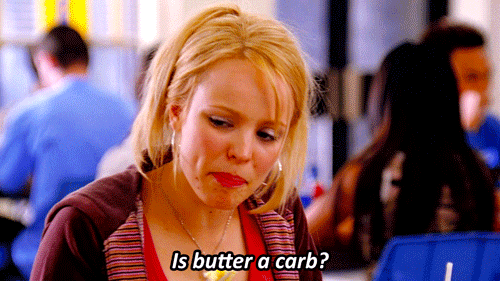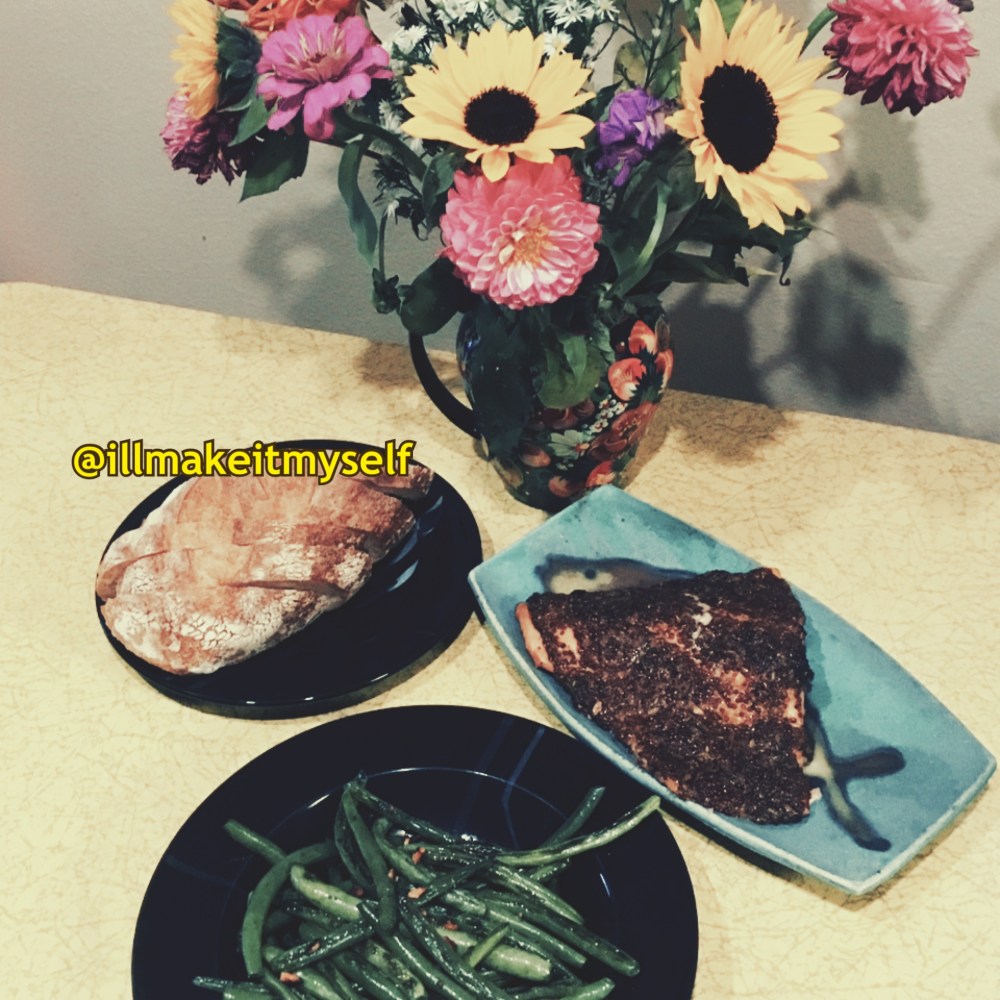Or, Supporting Your Partner Through a Dietary Change for Medical Reasons When You’re Tired, Queer, and Have a History of Disordered Eating
Interested in even more content? Patrons get recommended recipes, recipes in testing, and new recipes before anyone else. This recipe debuted on Patreon in October 2018. Your support helps pay for website hosting, reprinting zines, tabling at cons, our P.O. Box, and maybe more!

You can also get this on a handsome postcard-size recipe card at events! Or shoot me a Ko-Fi for at least $3 and I will send you one in an envelope!
Content warning and disclaimers:
This essay is about trying to find resources for dietary changes for medical reasons as a person with a history disordered eating. It describes in detail how disordered eating under the guise of “healthy living” shows up on social media and lifestyle blogs. There are some descriptions of how my eating disorder manifested that may be triggering. Finally, the dietary shifts I’m describing are a doctor’s recommendation for the experimental treatment of a specific medical condition. I’m not a doctor or a nutritionist. I’m also not here to debate with you about dietary changes for medical reasons. I definitely do not want to hear about your weight-loss journey, your sick gains, or doing yoga at sunrise.
Please note that unless otherwise specified, when I write diet I mean dietary habits. I have tried to avoid using the word diet as much as possible, but it is impossible not to use in some situations. I also added some pictures and gifs to lighten the mood, because joking is how I cope.
Throw Bread on Me

A few times a week, I have to go through my Instagram and block accounts that follow me. Sometimes it’s the usual spam and bots, but sometimes it’s all the #cleaneating folks who come out of the woodwork whenever I use hashtags for a picture of a meal—often vegan or gluten-free meals. Having more followers would be great, except that this subset is usually trying to get me to follow them back and their content is, to put it bluntly, white cisgender people cataloguing their orthorexia.
In 2018, I wrote a long piece about the nexus of orthorexia (a category of eating disorder that manifests as an obsession with “clean eating” and “healthy living”), abuse, Midwestern identity, and queerness for Comestible Issue 7. Finally naming my eating disorder, discussing my ex-husband’s queerphobic abuse, and writing it all out was therapeutic, especially since I’ve been in a good, actually healthy place about my relationship to food, exercise, and my body for a few years. Then, late last month, my partner’s medical team recommended a low-carb diet to try to treat some of the symptoms of a chronic medical condition they have. This way of eating is not about avoiding gluten but rather trying to eat a very small amount of carbohydrates by eliminating most grains and sugar; it’s closer to a low-glycemic diet for diabetes and (a less meat-heavy version of) keto than it is to a gluten-free diet for celiac.
There are a few challenges we’re running into right off the bat. First, although we cook from scratch most of the time, up until now we’ve been relying on grains bulk up many of the (mostly vegetarian) meals we cook: cornbread with vegetarian chili, rice with okazu and fish; and, of course, a seemingly endless supply of pasta and pizza topped with seasonal ingredients. Shifting away from centering our meals around grains is requiring both of us to completely rethink even our go-to meals. While I’m not following these low-carb guidelines myself, we usually cook together and eat leftovers as lunch. I’m trying to make as many dishes that we can share as possible, and they’re cooking what they can eat and sometimes making me some rice or oatmeal on the side.
The SnackWells of People

Gif via Giphy. Regina George from Mean Girls says, “Is butter a carb?”
Second, if you follow this blog, you know how much I like to bake and make desserts. Most of my recipes contain sugar and wheat flour, and even the gluten-free recipes I know still use sweeteners that will probably be reserved for guests and special occasions for as long as this new way of eating continues. I’ve started preliminary research about low-carb, low-sugar desserts that I can make more regularly, and although I’m excited for the new challenge, the process of doing this research has introduced a third problem: the research is causing me to keep having flashbacks to the peak of my eating disorder in Japan.
Ten years ago, the problem phrase for me was “healthy living.” I was cooking from scratch and cooking alone for the first time, and I wanted to eat a balanced diet. Instead, I got sucked into a black hole of “healthy living bloggers” of the mid-to-late 2000s and early ’10s. Healthy living bloggers (HLBs), basically the SnackWells of people, typically offer(ed) up a combination of low-fat, low-calorie recipes and workout tips, sometimes including fashion and home decorating in their writing. Many HLBs I encountered had/have distinctly orthorexic or anorexic eating patterns, over-exercising and eating “safe” foods. You can’t keep an eating disorder out of the subtext of your blog or social media any more than I can keep my queerness or prior food issues out of mine.
HLBs introduced me to “healthy” desserts, which involved a lot of low-fat homemade mug cakes. If you’ve never had the distinct displeasure of making a mug cake, it’s a cake recipe for one that you cook by microwaving it in a coffee mug. One blogger always recommended using applesauce or no-calorie sweetener, and it invariably tasted like disappointment. (Apparently you can buy mug-cake mix now at the store, which I discovered this week while examining alternative sweeteners. FUN.) Anyway, healthy desserts were one of my favorite ways of restricting, so I got pulled in even further to this HLB feedback loop.
To complicate matters further, many of the healthy living bloggers I followed were Nice White Cis Straight Ladies™ who reinforced a lot of the gendered body bullshit I was already dealing with as a queer nonbinary person being repeatedly shoved into the closet by my abusive now-ex. Between him and his family, HLBs, the culture I grew up in, and my resulting eating disorder, I thought that no one would love me if I weren’t thin and if I couldn’t perform what I now recognize as heterocentric girl drag: don’t wear that, don’t get too muscular, gosh I wish I were that thin, don’t cut your hair you’ll look like a boy, why can’t you just be normal, you’re probably just gay*–
Through trial and error, I found a number of trusted blogs and books that gave me the tools I needed to learn to cook the food I like without being body-shamed, gendered, or exposed to other people’s eating disorders. But with this research into cooking low-carb, I feel like I have to start sorting through the disordered bullshit all over again, and I’m already sick of it.
I don’t mean to imply that everyone who eats low-carb or keto is doing it because of an eating disorder, but I see a lot of same rhetoric I encountered ten years ago when I was teaching myself how to cook: decadent, guilty, “crack,” healthy, and diet (for more on this, see Soleil Ho’s “Words You’ll Never See Me Use in Restaurant Reviews”), assumptions about who might be interested in eating a certain way and why (weight loss, muscle gain, “to be healthy”), fat shaming, ab pictures, promises of miracle cures, etc. And while I can say that I’m out of the woods on being triggered by the accounts themselves, I don’t want to read about someone’s disordered eating habits while I’m looking for recipes, and I don’t want to support influencers who are making money from shaming others and stoking eating disorders.



Gif set from G.B.F. by mean-boyz
Shley tries to hand Tanner a container of brownies. Fawcett grabs the container and throws it into the trash.
Fawcett: Gays don’t do carbs!
Caprice: (shrugs) Yeah, carbs to a ‘mo is like sunlight to a vampire.
Shley: (confused) Carbs make gay people sparkle?**
Where I’m starting is with manufacturers of ingredients like coconut flour and almond flour: looking on the websites of Bob’s Red Mill and King Arthur Flour for recipes that have been tested and likely work, and that don’t shame me about my body or make gendered assumptions about me and my partner. (I wish I could say the same of the bloggers featured on their social media.) An old friend sent me some recipes and recommendations for apps for my partner to track carbs and sugar without making it about weight loss; I found at least one diabetic food blogger who seems safe from diet/gender bullshit so far, and I hope to find more. (The Specific Carbohydrate Diet book I got was fine until it claimed SCD can “cure” autism, which literally what the fuck, there are so many things wrong with that.) If you have any suggestions for low-carb/diabetic/keto books and blogs that are vegetarian-friendly, body positive, don’t do binary gender bullshit, please send me a link in the comments! Bonus points for queer, trans and/or POC authors.
I’m also going through the recipes we make all the time at home to see which can stay in rotation and which might be able to be altered. The recipe I’m sharing today from my Patreon bonus recipes, and one we make regularly since we’re able to get fresh salmon from vendors at our local farmers markets. It has 1 TBSP of brown sugar for 3-4 servings, which is low enough for my partner’s needs, but you can omit the sugar if needed.
Useful Links
Soleil Ho talks to guests on Bitch Media’s podcast Popaganda about “Watching What You Eat”: food insecurity, food sovereignty, and the problem with “clean eating.”
Soleil Ho also nailed it with “Words You’ll Never See Me Use in Restaurant Reviews” for the San Francisco Chronicle, which covers problematic (body-shaming, racist, gendered) terms frequently used to describe food.
Sam Dylan Finch writes about mental health, recovery from eating disorders, and body positivity from a genderqueer and transgender perspective on Let’s Queer Things Up! and elsewhere.
Julia Turshen wrote this beautiful piece for The Washington Post about supporting her wife through dietary changes for Type 1 Diabetes: “Our love was a stack of pancakes covered in butter, maple syrup and whipped cream. And then it wasn’t.”

Recipe: Roasted Salmon with Mustard and Herbs
Recipe Notes:
- You can reduce the amount of sugar or omit it if you need to—the sugar balances the flavors more but the sauce will still have the right consistency.
- I’ve also made this with half Dijon and half whole grain mustard, and even with half whole grain mustard and half yellow mustard.
Serves 3-4
Recipe by Robin and shared with permission.
Ingredients
- 1.5-2 pounds (680-900 g) filet king salmon (fresh or defrosted, bone in)
- Kosher salt
- Ground black pepper
For the sauce
- 3 TBSP (45 mL) Dijon mustard
- Juice of 1/2 large lemon
- 1 TBSP brown sugar
- 1 small sprig fresh rosemary, minced (about 1/2-1 tsp)
- 1 tsp fresh thyme, minced
- 3 fresh sage leaves, minced
Equipment
- A glass roasting pan (I used a 9×13″ pan)
- Instant-read thermometer (for meat)
- Small bowl
- Whisk
Procedure
- Preheat the oven to 450º F (230º C). Grease the pan/sheet.
- Combine the sauce ingredients in a small bowl and whisk to incorporate.
- Liberally sprinkle salt and pepper on both sides of the salmon and massage to evenly distribute. Place salmon skin down in roasting pan.
- Coat the top and sides of the salmon filet with the mustard sauce. Make sure to distribute evenly.
- Bake for 20-40 minutes, until internal temperature at the thickest point reaches 145º F (62º C).
Serving suggestion: Serve hot with green beans sautéed with garlic and butter. (I used garlic once and ramp butter another time.) If you have leftovers, they make an excellent quiche ingredient. I also like some bread and compound herb butter with this.
Note
*I’m actually bi, and I’m not attracted to garbage cis men anymore.
**Twilight reference. G.B.F. is a light-hearted, self-referential queer Mean Girls that I like, although it does have a weirdly biphobic moment and some casual cissexism.
2 Comments
Comments are closed.